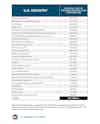 Neil Bradley
Neil Bradley
Executive Vice President, Chief Policy Officer, and Head of Strategic Advocacy, U.S. Chamber of Commerce
Published
July 30, 2018
In response to mounting frustration from farmers across the country, the administration last week proposed spending up to $12 billion of taxpayer money to compensate farmers and ranchers for the deep economic losses they are suffering as a result of the ongoing trade war. Notably, America’s agricultural community responded to the proposal by making clear they don’t want government aid; they want real solutions to open new markets, roll back tariffs, and stop the trade war.
They want trade, not aid.
While America’s agricultural industry has been hit extremely hard by escalating tariffs, it’s not alone. Thousands of U.S. companies – including manufacturers, input suppliers, fisherman, and businesses from numerous other industries – are finding it more difficult to sell American made products abroad amid the growing trade war.
But offering a bailout to any single industry is a slippery – and costly – slope.
The U.S. Chamber crunched the numbers to determine how much it would cost American taxpayers to extend the same relative level of financial aid the administration has proposed for farmers to other U.S. industries that have been negatively affected by retaliatory tariffs. As shown in the chart below this post, such an aid package would cost U.S. taxpayers an estimated $39 billion – $12 billion already extended to agriculture plus an additional $27 billion to support other affected sectors.
And let’s be clear: The best way to protect American industries from the damaging consequences of a trade war is to avoid entering into a trade war in the first place.
The administration’s focus should be expanding free trade and removing these harmful tariffs, not allocating taxpayer’s money to only marginally ease the suffering for some of the industries feeling the pain of the trade war. Or as Bill Gordon, a soybean farmer in Minnesota, recently put it: “We’d rather have trade. Any aid package, no matter what dollar amount, is a Band-Aid on an arterial bleed.”

Related: Discover how hard a trade war could impact your state.
About the authors

Neil Bradley
Neil Bradley is executive vice president, chief policy officer, and head of strategic advocacy at the U.S. Chamber of Commerce. He has spent two decades working directly with congressional committee chairpersons and other high-ranking policymakers to achieve solutions.





